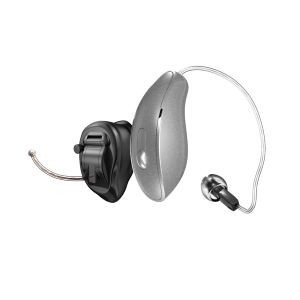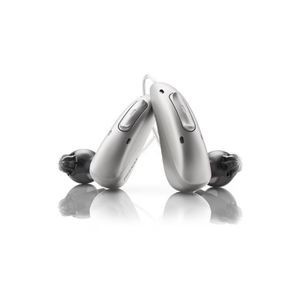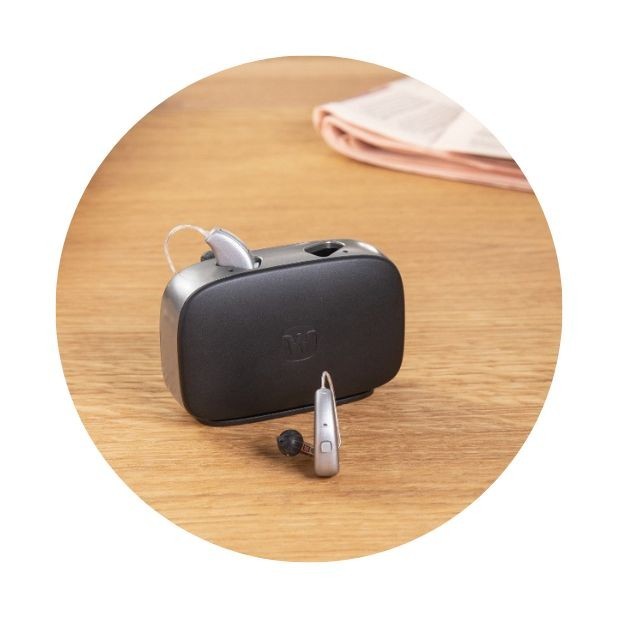
Latest Hearing Aid UK Update: 05/01/2026
Rechargeable Hearing Aids
Including the best rechargeable hearing aids 2026
For those who are active and have hearing loss, fully charged and reliable hearing solutions are important.
Rechargeable hearing aids are a great option with batteries that last 24 hours or more on a single charge (in some cases).
Rechargeable hearing aids are designed to keep up with your life and offer Bluetooth capability and app syncs that will deliver a host of personalisations that can support your hearing whilst on the go.
Rechargeable hearing aids have, in many ways, revolutionised the field of audiology. It provides numerous benefits to individuals with hearing loss.
These devices, powered by rechargeable batteries, offer convenience, environmental sustainability, cost savings, improved performance, and accessibility.
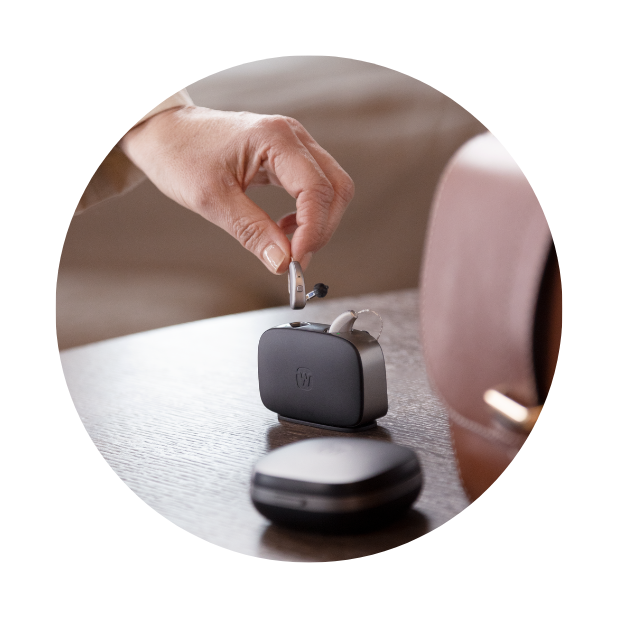
One of the most significant advantages of rechargeable hearing aids is the convenience they give
Gone are the days of fumbling with tiny disposable batteries and worrying about their lifespan.
With rechargeable hearing aids, users can simply place their devices in a charging station, making the overall experience more user-friendly and hassle-free.
Here, we go through the benefits and features of rechargeable hearing aids, and how they can support your hearing and deliver advanced technology.
Our audiologist, Paul Harrison, expertly recommends the best rechargeable hearing aids on the market today.
Read on to discover more about the best rechargeable hearing aids and whether they are the right fit for you and your hearing loss.
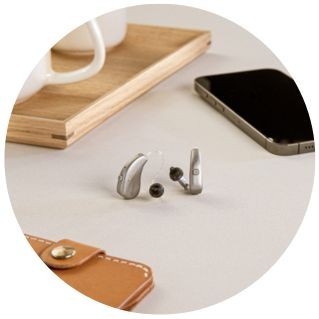
Battery vs rechargeable hearing aids
Why use rechargeable hearing aids?
Are rechargeable hearing aids better?
Rechargeable hearing aids are a type of hearing aid that uses a rechargeable battery instead of disposable batteries. These types of hearing aids can be convenient and cost-effective for people with hearing loss, as they eliminate the need to constantly purchase and replace batteries.
One of the main benefits of rechargeable hearing aids is their convenience. With traditional hearing aids, users need to constantly purchase and replace batteries, which can be inconvenient and costly.
Rechargeable hearing aids, on the other hand, can be charged using a charging station or a micro USB cable, which means that users only need to replace the battery every few years (depending on the specific hearing aid).
What are the differences between traditional and rechargeable hearing aids?
There is a definitive gap between the digital hearing aids of today and the ones your parents or grandparents used to use. Alongside Bluetooth technology, one of the most exciting recent developments is rechargeable hearing aids.
Hearing aids are either powered by disposable or rechargeable batteries. Whilst traditional batteries are still popular, more people are looking to the freedom and convenience of rechargeables. Industry predictions indicate that soon rechargeable solutions will become more attractive to consumers than traditional ones.
Phonak was the first hearing aid manufacturer to include rechargeable lithium-ion batteries in their devices, which simply mirrors the technology found in your smartphone and other rechargeable consumables. Providing a reliable connection and power even to the most power-hungry of Bluetooth devices.
Around four years later, all the rest of the main hearing aid brands followed suit, as constant technological advancements led to increasing battery life and paved the way for more malleable and smaller form factors.
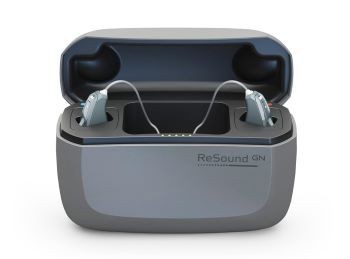
Is this the last redoubt of disposable batteries?
For a long time, hearing aids have relied solely on disposable zinc-air batteries. It’s easy to see why, as they are cheap, simple to replace, and widely available.
But with rechargeable technology making headway in other consumer devices such as smartphones, e-readers, and tablets, people started to demand the same convenience with their hearing aids.
You might be thinking about upgrading, switching to a rechargeable device, and preferring not to change your batteries. You won't be on your own, as hearing aid wearers are now making it obvious that they prefer rechargeable models over disposable ones.
Saying that they are not for everyone, along with useful information, discovering what's available, and our review further down the page, we hope to help you decide whether they are right for you.
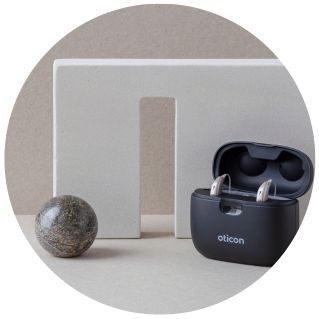
Are rechargeable hearing aids worth it?
What are the advantages of rechargeable hearing aids?
Are rechargeable hearing aids better than battery-powered ones?
There are many reasons to take advantage of lithium-ion rechargeable hearing aid technology. Take a look at the rechargeable hearing aid pros and how they work to see if you think investing in them would be a benefit to you.
1. Rechargeable hearing aids are more convenient
If you are wondering how rechargeable hearing aids work, you simply place the rechargeable hearing aids in the charging dock overnight to charge, and your hearing devices are primed and ready to go in the morning.
Most models take advantage of inductive charging, which makes it even easier to charge your hearing aids before bed. You don't have to remember to buy batteries or carry spares, and your battery won't let you down at the most inopportune times.
2. Rechargeable hearing aids are better for the environment
Rechargeable hearing aid batteries also contribute to saving the environment. Batteries are fairly difficult to recycle, and people don't usually make sure that they are carefully disposed of. Rechargeable batteries must, of course, also be carefully disposed of, but this is much less often than the average hearing aid battery!
They often contain heavy metals and other toxic substances that can leach into the soil and water. These are usually corrosive materials and are commonly found in many hearing aid batteries because of the battery production process.
The casing can disintegrate if the batteries are not properly disposed of, causing these harmful substances to leak into the environment.
This can lead to soil and water contamination and can negatively affect animals as well as humans. Rechargeable hearing aids, on the other hand, are more environmentally friendly, as they can be charged and reused multiple times.
3. Rechargeable hearing aids are better for the less dexterous
You don't have to mess with small batteries every few days with rechargeable hearing aid batteries. If someone has visual or dexterity issues, the small size of conventional disposable hearing aid batteries and hearing aids themselves can be tricky to replace.
4. The new rechargeable batteries are better
Batteries did not need to be replaced often with older hearing aid models because they had no wireless or digital functionality. But traditional zinc-air batteries do not last as long as they once did with newer hearing aid models, because of today's more advanced technology.
You could have to switch the batteries a few times a week, instead of once a month. But lithium-ion rechargeable hearing aid batteries can keep up with all the power needs of today's digital technology while maintaining enough charge for an entire day of hearing.
5. There are additional features with rechargeable hearing aids
In addition to these benefits, rechargeable hearing aids may also offer some additional features that can improve the overall listening experience. For example, many models come with noise reduction and feedback reduction technologies, which can help to improve speech understanding in noisy environments.
They may also come with directional microphones, which can help to improve speech understanding by focusing on the person speaking in front of the wearer.
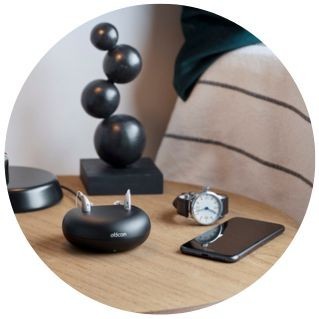
Disadvantages of rechargeable hearing aids
Are there any cons to rechargeable hearing aids?
What are the disadvantages of rechargeable hearing aids?
While rechargeable hearing aids offer several advantages, they also come with a few potential disadvantages that individuals should consider before making a decision. Here are some of the drawbacks associated with rechargeable hearing aids:
1. Rechargeable hearing aids tend to be more expensive
Rechargeable hearing aids are usually more expensive than traditional battery-operated hearing aids.
The cost of the charging station or other accessories may need to be considered on top of the price of the hearing aids.
While the long-term savings on battery replacements may offset the initial investment, the higher upfront cost can be a barrier for those on a tight budget.
2. Rechargeable hearing aids have a limited battery life
Although rechargeable hearing aids offer the convenience of not having to replace batteries, they do have limited battery life and may require daily recharging.
Advancements have been made in battery technology; however, they may still require daily charging or may not last a full day, especially for those who require extended device use.
3. Rechargeable hearing aids rely on charging equipment
Rechargeable hearing aids depend on a charging station or other charging equipment, which may be lost or damaged, leading to a temporary loss of hearing ability.
These hearing aids require time to charge fully.
This means that if the battery runs out unexpectedly, you may need to wait for the hearing aids to recharge before you can use them again.
4. The rechargeable hearing aid's performance can be reduced in cold temperatures
Rechargeable batteries may perform poorly in cold temperatures, which can impact the performance of rechargeable hearing aids.
Don't forget to read our consumer tick list to help you make an informed decision if you are considering rechargeable hearing aids further down the page.
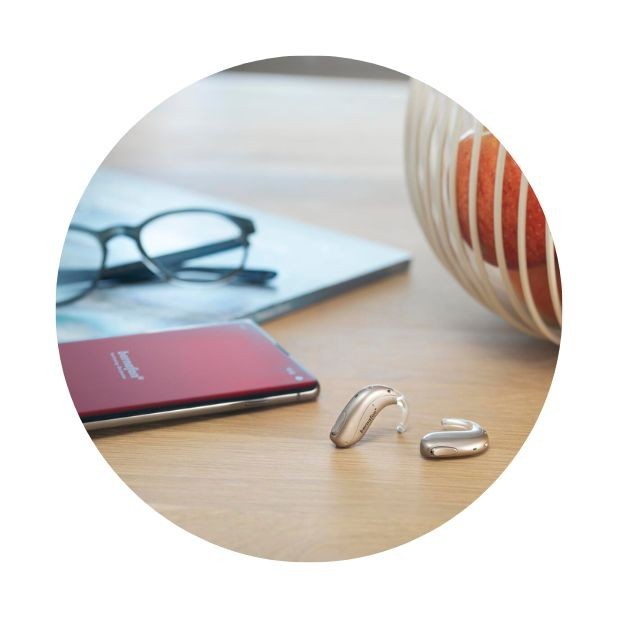
Best Rechargeable Hearing Aids Review UK 2026
Rechargeable hearing aids best buy for consumers
It's important to consult with a hearing healthcare professional or audiologist to determine if rechargeable hearing aids are suitable for your hearing loss and lifestyle.
However, our audiologists have provided a guide to the best three rechargeable hearing aids below, which we hope will help you select the best hearing aids for your needs.
This list will change throughout the year to reflect new hearing aid launches, advanced technology, and if we feel there is a better alternative.
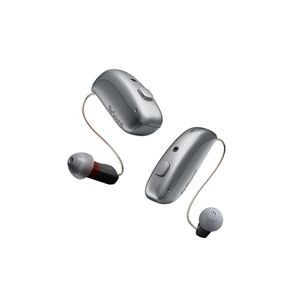
Winner
Resound Vivia rechargeable hearing aids
Why we picked it
The ReSound Vivia hearing aids are an excellent choice for anyone looking for a reliable and convenient rechargeable solution. Built with a sleek, modern design, they combine comfort, durability, and advanced hearing performance in one discreet device.
With a powerful rechargeable battery, Vivia provides up to 30 hours of use on a single charge, giving you confidence that your hearing support will last throughout even the busiest days. Thanks to fast-charging capability, you can quickly top up the battery when needed, adding extra flexibility to your routine and removing the hassle of regular battery changes.
Vivia also integrates advanced sound processing, including effective noise reduction, directional microphones, and feedback management. This ensures clearer speech understanding in challenging listening environments, reduced whistling, and consistent sound quality.
To match your lifestyle, the devices are available with a choice of premium, standard, or desktop chargers, while their protective nano-coating helps safeguard against moisture and daily wear.
Altogether, ReSound Vivia offers a dependable, user-friendly rechargeable hearing aid experience that combines convenience with cutting-edge technology.
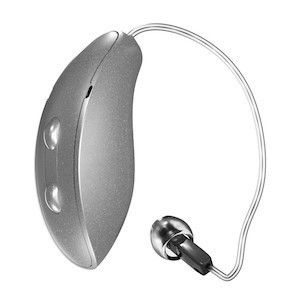
Second Place
Starkey Edge AI 24 rechargeable hearing aids
Why we picked it
This rechargeable hearing aid provides wearers with up to 80 million adjustments each hour, along with advanced rechargeable technology.
These cutting-edge hearing aids use their AI capabilities to redefine the way we process sound. This range also features Starkey's DNN (Deep Neural Network) and the industry's most advanced Neuro processor.
Starkey Edge AI 24 comes with improvements in battery life that can give up to 51 hours on a single charge, and with just 7 minutes of charging, 3 hours of use when using the Premium Custom Mini Charge, for on-the-go charging.
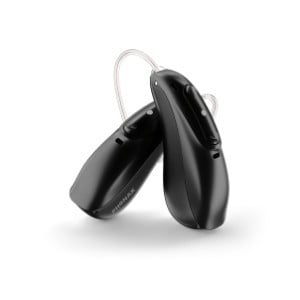
Runner Up
Phonak Audeo Infinio Ultra Sphere i90 rechargeable hearing aids
Why we picked it
The Phonak Audeo Infinio Ultra Sphere i90 hearing aids offer a seamless, rechargeable listening experience. With a powerful, long-lasting battery, these devices eliminate the need for frequent battery changes, providing all-day hearing clarity.
The quick-charge feature ensures you can top up the battery in a short amount of time, offering flexibility and convenience.
Designed to seamlessly integrate into your daily life, the i90 delivers exceptional sound quality and advanced features, all powered by a Phonak's reliable rechargeable battery.
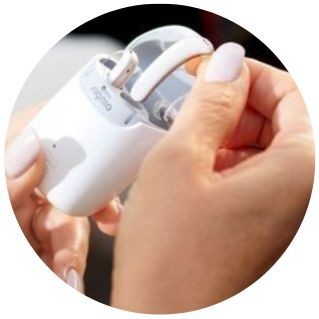
Best Rechargeable Digital Hearing Aids
The consumer rechargeable hearing aid ticklist
What should we be thinking about when considering digital rechargeable hearing aids?
Here is our consumer ticklist for those who are thinking about rechargeable hearing aids, and some ideas of questions you might want to ask your audiologist. We hope you find this criterion useful:
Battery life
Check the estimated battery life provided by the manufacturer. Ensure that the battery life is sufficient to meet your daily hearing needs - including streaming.
Charging options
Understand the charging options available for your hearing aids. Check if the hearing aids come with a charging system, charging case, or USB cable.
Consider which charging method best suits your lifestyle.
Charging time
Inquire about the approximate time it takes to fully charge the rechargeable hearing aids. Faster charging times can be advantageous, especially if you have an active lifestyle.
Power management
Explore if the hearing aids have power-saving features or advanced power management systems. These features can help extend battery life and optimise the usage of power throughout the day.
Compatibility
Ensure that the rechargeable hearing aids are compatible with your level of hearing loss. Different models cater to different hearing needs, so it's essential to find the right fit for your hearing profile.
Device style and fit
Consider the different styles and sizes of rechargeable hearing aids available. Choose a style that suits your preferences, comfort, and any specific physical considerations you may have.
This might be dexterity issues or the need for a discreet design.
Cost
Evaluate the cost of rechargeable hearing aids, including the initial purchase price and any additional accessories or charging devices required that might be extra.
Compare the long-term cost savings of rechargeable batteries versus disposable batteries.
Warranty and support
Inquire about the warranty provided by the manufacturer and the availability of aftercare support.
Are rechargeable hearing aids right for you?
Looking for the best rechargeable hearing aids near me? Despite the many benefits, there are also some potential drawbacks to consider when it comes to hearing aids with rechargeable batteries. One potential issue is that they may require frequent charging, which can be inconvenient for people who are always on the go.
Overall, rechargeable hearing aids can be a convenient and cost-effective option for people with hearing loss. If you are considering this type of hearing aid, it's a good idea to speak with an audiologist call us free on 0800 567 7621
What's included in our hearing aid prices?
Our specialist service includes:
Do not spend hundreds of pounds without getting a second opinion from us.
Please call us on 0800 567 7621
 Not only are the prices great, but the service is fantastic! Many thanks to your team.
Not only are the prices great, but the service is fantastic! Many thanks to your team.Watch Phonak's video about the benefits of rechargeable hearing aids below
Common questions about rechargeable hearing aids
Do rechargeable hearing aids have batteries?
The batteries are built into the rechargeable hearing aids and they don't need to be changed or removed like disposable battery-operated devices. Instead, you simply put your hearing aids in the charging system overnight, like you would do your mobile, and have a fully charged hearing solution to wake up to.
Are rechargeable hearing aids better than a traditional battery?
Successive iterations of rechargeable digital hearing aid technology were subsequently developed, each improving on the last. But the latest development, called lithium-ion technology, maybe the best yet. This game-changing technology is the first to achieve full days worth of power on one charge.
What do rechargeable hearing aids look like?
Rechargeable hearing aids generally look the same as the ones that require you to change the battery. In some cases, the shape might be more slim-lined or shorter, as the model doesn't have a battery compartment door.
How much are rechargeable hearing aids?
Are rechargeable hearing aids more expensive? If you are wondering how much rechargeable hearing aids cost - expect to pay slightly more for these types of devices. Rechargeable hearing aids are generally premium products from the industry's top hearing aid brands.
As a rough guide of the average cost of rechargeable hearing aids - a pair usually starts from around £1,095 (based on our prices). However, it really depends on what features and functions they have as well as the hearing aid manufacturer.
Are there affordable rechargeable hearing aids?
Is there such a thing as cheap rechargeable hearing aids? We know that 'cheap' is subjective and what one person thinks is expensive differs from another.
However, there are great examples of affordable rechargeable hearing aids on the market to choose from that your audiologist can show you.
How long does rechargeable hearing aid's battery life last?
How long do the batteries in rechargeable hearing aids last? Pretty much all rechargeable hearing aid manufacturers state that their ranges offer a full day of power in one single charge, then you can recharge them while you sleep. The duration of battery life depends on how you use your hearing aids. For instance, if you stream quite a lot during the day - the batteries won't last as long.
How do you dry rechargeable hearing aids?
Drying rechargeable hearing aids is easy, you can purchase a rechargeable hearing aid dryer online or through your audiologist.
Rechargeable hearing aid dryers are devices used to dry and maintain the performance of rechargeable hearing aids. These dryers are designed to remove moisture, sweat, and other forms of condensation from rechargeable hearing aids, helping to prevent damage and extend their lifespan.
How do you clean rechargeable hearing aids?
When cleaning rechargeable hearing aids, always avoid using water, solvents, or abrasive cleaning materials, as these can damage hearing aids. Also, always refer to the manufacturer's instructions for specific cleaning and maintenance guidelines for your hearing aids.
Are rechargeable hearing aids available on the NHS?
Can you get rechargeable hearing aids on NHS? Yes, rechargeable hearing aids are available on the National Health Service (NHS) in the UK. The availability of rechargeable hearing aids through the NHS depends on several factors, including your individual hearing needs, the resources available in your local area, and the decisions made by local clinical commissioning groups (CCGs).
Other pages you might find useful
FAQs
In general, any audiologist will always recommend to you the hearing aid model that best suits your needs. Here is a useful checklist to make sure that is the case.
- Audiologist's level of knowledge: The audiologist you have seen will hopefully have a wide knowledge of all available hearing aids; however, some will only be familiar with a small number of brands and, therefore, may not really be in a position to know which model is the best for you. It is OK to challenge their recommendation and ask them to justify why this particular brand is the one for you.
- Do research: Read about the hearing aid that was recommended. Does it seem like it will suit your lifestyle? Does it have more or fewer features than you need?
- Be aware of sales targets: Many high street retailers have specific tie-ins to a particular manufacturer/brand. The hearing aid they have suggested may still be the correct one for you, but do your research so that you know why they might have recommended it.
If you have significant hearing loss in both ears, you should be wearing two hearing aids. Here are the audiological reasons why:
Localisation: The brain decodes information from both ears and compares and contrasts them. By analysing the minuscule time delays as well as the difference in the loudness of each sound reaching the ears, the person is able to accurately locate a sound source.
Simply put, if you have better hearing on one side than the other, you can't accurately tell what direction sounds are coming from.
Less amplification is required: A phenomenon known as “binaural summation” means that the hearing aids can be set at a lower and more natural volume setting than if you wore only one hearing aid.
Head shadow effect: High frequencies, the part of your hearing that gives clarity and meaning to speech sounds, cannot bend around your head. Only low frequencies can. Therefore, if someone is talking on your unaided side, you are likely to hear that they are speaking, but be unable to tell what they have said.
Noise reduction: The brain has its own built-in noise reduction, which is only really effective when it is receiving information from both ears. If only one ear is aided, even with the best hearing aid in the world, it will be difficult for you to hear in background noise as your brain is trying to retain all of the sounds (including background noise) rather than filtering them out.
Sound quality: We are designed to hear in stereo. Only hearing from one side sounds a lot less natural to us.
Fancy some further reading on this topic? You can read about why two hearing aids are better than one in our article, hearing aids for Both Ears, here
For most people, the main benefit of a rechargeable hearing aid is simple convenience. We are used to plugging in our phones and other devices overnight for them to charge up. Here are some other pros and cons:
For anybody with poor dexterity or issues with their fingers, having a rechargeable aid makes a huge difference, as normal hearing aid batteries are quite small and some people find them fiddly to change.
One downside is that if you forget to charge your hearing aid, then it is a problem that can't be instantly fixed. For most, a 30-minute charge will get you at least two or three hours of hearing, but if you are the type of person who is likely to forget to plug them in regularly, then you're probably better off with standard batteries.
Rechargeable aids are also a little bit bigger and are only available in Behind-the-Ear models.
Finally, just like with a mobile phone, the amount of charge you get on day one is not going to be the same as you get a few years down the line. Be sure to ask what the policy is with the manufacturer's warranty when it comes to replacing the battery.
For most people, the answer is yes. But it's never that simple.
The majority of hearing problems affect the high frequencies a lot more than the low ones. Therefore, open fitting hearing aids sound a lot more natural and ones that block your ears up can make your own voice sound like you are talking with your head in a bucket. Therefore, in-ear aids tend to be less natural.
However, the true answer is we can't tell until we have had a look in your ears to assess the size of your ear canal, and until we have tested your hearing to see which frequencies are being affected.
People with wider ear canals tend to have more flexibility, also there are open fitting modular CIC hearing aids now that do not block your ears.
There is also the age-old rule to consider, that a hearing aid will not help you if it's sat in the drawer gathering dust. If the only hearing aid you would be happy wearing is one that people can't see, then that's what you should get.
Most people can adapt to any type of hearing aid, as long as they know what to expect. Have an honest conversation with your audiologist as to what your needs are.
Generally speaking, six or more. Unless it's none at all. The number of channels a hearing aid has is often a simplistic way an audiologist will use to explain why one hearing aid is better than another, but channels are complex, and it is really not that straightforward. Here are some reasons why:
Hearing aids amplify sounds of different frequencies by different amounts. Most people have lost more high frequencies than low, and therefore need more amplification in the high frequencies. The range of sounds you hear is split into frequency bands or channels, and the hearing aids are set to provide the right amount of hearing at each frequency level.
Less than six channels, and this cannot be done with much accuracy, so six is the magic number. However, a six-channel aid is typically very basic with few other features and is suitable only for hearing a single speaker in a quiet room. The number of channels is not what you should be looking at; it's more the rest of the technology that comes with them.
As a final note, different manufacturers have different approaches. One method is not necessarily better than any other. For example, some manufacturers have as many as 64 channels in their top aids. Most tend to have between 17 and 20. One manufacturer has no channels at all.
Manufacturer's warranties typically last between 2-5 years, depending on the brand and model, and cover defects in materials and workmanship. This includes repairs for component failures, electronic malfunctions, and manufacturing defects, but excludes damage from misuse, accidents, or normal wear. Most manufacturers also include loss and damage insurance for the first year.
We handle all warranty claims on your behalf, liaising with manufacturers and ensuring you get replacement devices quickly when needed. This comprehensive warranty coverage, combined with our lifetime aftercare, gives you complete peace of mind.
Our hearing tests are completely free, whether at our clinics or in your home. Unlike other providers who charge £30-£100 for home visits, we believe hearing healthcare should be accessible without financial barriers. Our comprehensive assessments include examination by a registered audiologist, audiogram results, and personalised recommendations.
All testing, future adjustments, and ongoing support are included at no extra cost. While NHS tests are also free, typical 6-week waiting periods often lead people to seek immediate private testing. We provide prompt, professional assessments that fit your schedule and budget.
Yes, we offer completely free home visits throughout the UK, and this service is included in our prices with no additional charges. Home visits are particularly valuable for people with mobility issues, busy schedules, or those who simply prefer the comfort and convenience of their own environment.
Our audiologists can conduct full hearing tests, fit hearing aids, and provide ongoing support in your home. This service sets us apart from many providers who either don't offer home visits or charge extra for them.
We can offer prices up to 40% lower than high street retailers because of our business model. As a network of 200+ independent audiologists, we don't have the massive overheads of large retail chains - no expensive high street premises, no sales targets pushing audiologists to sell the most expensive options, and no costly marketing campaigns.
However, we maintain the same buying power as the big chains because we purchase on behalf of our entire nationwide network. This means you get access to the same premium hearing aids with professional service, but at genuinely competitive prices.
We offer a comprehensive 60-day money-back guarantee, which gives you twice the industry standard time to properly assess whether your hearing aids are right for you. This extended period recognises that adjusting to hearing aids takes time, and your brain needs several weeks to adapt to the amplified sounds.
Unlike many providers who offer just 30 days, we believe 60 days gives you the confidence to test your hearing aids in all the situations that matter to you - from quiet conversations at home to busy restaurants and outdoor activities.
Ask the Experts
6 Morton Lane
Walkwood
Redditch
Worcestershire
B97 5QA
Latest Launch
When we refer to a product as 'Latest Launch', we mean it is the latest to be released on the market.
New
When we refer to a product as 'New', we mean that the product is the newest hearing aid model on the market.
When we refer to a product as 'Superseded', we mean that there is a newer range available which replaces and improves on this product.
Older Model
When we refer to a product as an 'Older Model', we mean that it is has been superseded by at least two more recent hearing aid ranges.


